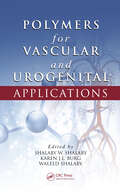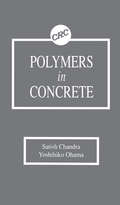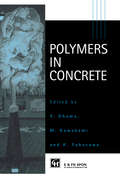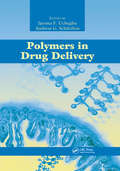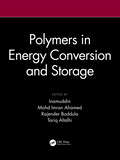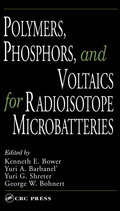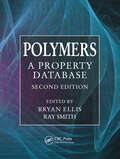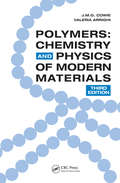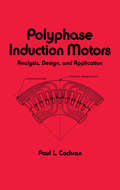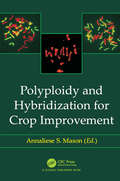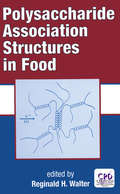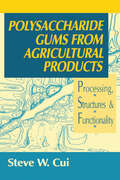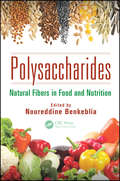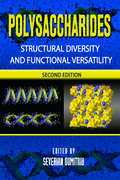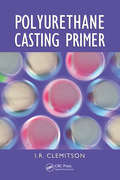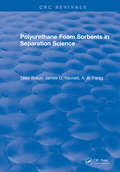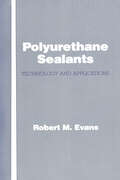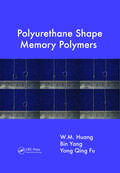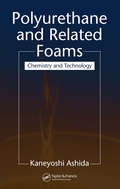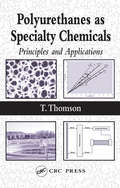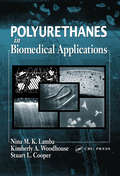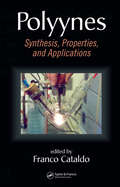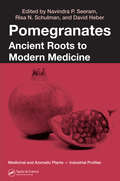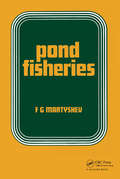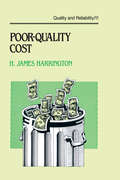- Table View
- List View
Polymers for Vascular and Urogenital Applications (Advances in Polymeric Biomaterials)
by Karen J.L. Burg Shalaby W. Shalaby Waleed ShalabyIn a carefully crafted, multidisciplinary, skillfully focused format, Polymers for Vascular and Urogenital Applications covers attributes of polymers used for vascular, urological, and gynecological materials. It provides a brief analysis of how the use of polymers in vascular and urogenital applications has evolved in the past five decades and out
Polymers in Concrete
by Satish Chandra Yoshihiko OhamaThis broad-based, introductory reference provides excellent discussions regarding the hydration of Portland cement, durability problems in concrete, mechanisms of concrete deterioration, and interaction of polymers in concrete. It also covers properties of concrete with added polymers and practical applications of polymers in concrete. The historic background of polymers in building materials is examined, and a comprehensive comparison of natural vs. synthetic polymers is provided and conveniently summarized in a tabular format.
Polymers in Concrete
by Yoshihiko Ohama Makoto Kawakami Kimio FukuzawaIncreasing attention is being given to the use of concrete-polymer composites as high performance and multi-functional materials in the construction industry, as well as in mechanical, electrical and chemical engineering. Particular interest is being given to these materials in Japan and other East Asian countries. This book forms the proceedings o
Polymers in Drug Delivery
by Ijeoma F. Uchegbu Andreas G. SchatzleinTogether, the nano explosion and the genomic revolution are ushering in a new frontier in drug delivery. In recent years we've seen how polymers can play a crucial role in controlling the rate of drug release, enhancing solubility and uptake, and limiting degradation and toxicity. In the very near future, they may well be used to deliver gene thera
Polymers in Energy Conversion and Storage
by Inamuddin Mohd Imran Ahamed Rajender Boddula Tariq AltalhiThe research and development activities in energy conversion and storage are playing a significant role in our daily lives owing to the rising interest in clean energy technologies to alleviate the fossil-fuel crisis. Polymers are used in energy conversion and storage technology due to their low-cost, softness, ductility and flexibility compared to carbon and inorganic materials. Polymers in Energy Conversion and Storage provides in-depth literature on the applicability of polymers in energy conversion and storage, history and progress, fabrication techniques, and potential applications.Highly accomplished experts review current and potential applications including hydrogen production, solar cells, photovoltaics, water splitting, fuel cells, supercapacitors and batteries. Chapters address the history and progress, fabrication techniques, and many applications within a framework of basic studies, novel research, and energy applications.Additional Features Include: Explores all types of energy applications based on polymers and its composites Provides an introduction and essential concepts tailored for the industrial and research community Details historical developments in the use of polymers in energy applications Discusses the advantages of polymers as electrolytes in batteries and fuel cells This book is an invaluable guide for students, professors, scientists and R&D industrial experts working in the field.
Polymers, Phosphors, and Voltaics for Radioisotope Microbatteries
by Kenneth E. Bower Yuri A. Barbanel’ Yuri G. Shreter George W. BohnertAs the first book written solely on the subject of nuclear batteries and their potential to revolutionize the electronics industry, this text will appeal to a broad audience, from engineers to energy policy makers. This collection of contributions from leading U.S. and Russian nuclear researchers contains diverse discussions of the problems of using radioactive material for microelectronic power needs, and it guides readers to future research in the area of long-life, high energy-density batteries. It describes the state of interdisciplinary research in radiochemistry, tritium storage, semiconductor fabrication, integration into MEMS and other electronic devices, and much more.
Polymers: A Property Database, Second Edition
by Ray Smith Bryan EllisA reliable source for scientific and commercial information on over 1,000 polymers, this revised and updated edition features 25 percent new material, including 50 entirely new entries that reflect advances in such areas as conducting polymers, hydrogels, nano-polymers, and biomaterials. The second edition also comes with unlimited access to a complete, fully searchable web version of the reference. Powerful retrieval software allows users to customize their searches and refine results. Each entry includes trade names, properties, manufacturing processes, commercial applications, supplier details, references, and links to constituent monomers.
Polymers: Chemistry and Physics of Modern Materials, Third Edition
by Valeria Arrighi J.M.G. CowieUnderscoring the multidisciplinary nature of polymer science, this third edition provides a broad-based and comprehensive text at an introductory, reader-friendly level. With nearly 50 percent new or updated material, this edition presents new polymerization methods, characterization techniques, and applications in electronic, biological, and medical settings. New topics include controlled radical polymerization, novel polymer architectures, chain dimension, morphology, determining molecular weights, metallocene catalysts, copolymers, and rheological behavior. The book features real world examples, new chapter problems, and a solutions manual.
Polyphase Induction Motors, Analysis: Design, and Application (Electrical and Computer Engineering)
by Paul CochranGenerously illustrated with over 1600 dispaly equations and more than 145 drawings, diagrams and photographs, this book is a handy, single-source reference suited to readers with a wide span of educational backgrounds and technical experience. Comprehensive in both scope and depth this manual covers all significant aspects of the field, such as Amperes Law and Faraday's Law, emphasing basic explanations of motor behaviour, derives all important equations and relationships required to analyze, design and apply polyphase induction motors, uses worldwide SI units or international MKS system of units as well as practical units used in the US and shows how to apply working equations to real-life situations with numerical examples... and more.
Polyploidy and Hybridization for Crop Improvement
by Annaliese S. MasonMany of our current agricultural crops are natural or agricultural hybrids (between two or more species), or polyploids (containing more than one genome or set of chromosomes). These include potato, oats, cotton, oilseed rape, wheat, strawberries, kiwifruit, banana, seedless watermelon, triticale and many others. Polyploidy and hybridization can also be used for crop improvement: for example, to introgress disease resistance from wild species into crops, to produce seedless fruits for human consumption, or even to create entirely new crop types. Some crop genera have hundreds of years of interspecific hybridization and ploidy manipulation behind them, while in other genera use of these evolutionary processes for crop improvement is still at the theoretical stage. This book brings together stories and examples by expert researchers and breeders working in diverse crop genera, and details how polyploidy and hybridization processes have shaped our current crops, how these processes have been utilized for crop improvement in the past, and how polyploidy and interspecific hybridization can be used for crop improvement in the future.
Polysaccharide Association Structures in Food (ISSN)
by Reginald H. WalterFocuses on the physical-chemical origins and structures formed by the association of aqueous, dispersed polysaccharides with related and unrelated chemical species. Covers the origin of polysaccharide supramolecular assemblies; polysaccharide molecular structures; gel formation and ultrastructure in food polysaccharides; structures and phase transitions of starch polymers; microcrystalline cellulose technology; cyclodextrins; starch-lipid interactions; interactions in whey protein/polysaccharide mixtures; and more.
Polysaccharide Gums from Agricultural Products: Processing, Structures and Functionality
by Steve W. CuiThis new reference presents the most recent information on new and potential food hydrocolloids originated from agricultural products, including o yellow mustard gum o flaxseed gum o cereals (wheat, barley, oat, and corn)o psyllium fenugreek o soybean. Polysaccharide Gums from Agricultural Products: Processing, Structures and Functionality addresse
Polysaccharides: Natural Fibers in Food and Nutrition
by Noureddine BenkebliaThis book reviews the evidence supporting the influence of plant fibers on our daily life by either having impacts on our nutrition or improving processed foods for human and animal feeding. By bringing new information and updating existing scientific data, this book will also be a consistent source of information for both professional and non-prof
Polysaccharides: Structural Diversity and Functional Versatility, Second Edition
by Severian DumitriuCompletely revised and expanded to reflect the latest advancements in the field, Polysaccharides: Structural Diversity and Functional Versatility, Second Edition outlines fundamental concepts in the structure, function, chemistry, and stability of polysaccharides and reveals new analytical techniques and applications currently impacting the cosmeti
Polyurethane Casting Primer
by I.R. ClemitsonOmitting complicated chemistry concepts, Polyurethane Casting Primer presents practical details on the casting of polyurethane products to assist readers in their daily work. It covers fundamental methods, explores hands-on design and production topics, and keeps theory to a minimum.The book fully explains casting and allied processes. Starting fro
Polyurethane Foam Sorbents in Separation Science
by BraunThe purpose of this book is to present in a monographic and systematised form a review of all the literature devoted to polyurethane-based polymeric sorbents in separation chemistry. The primary types of sorbents dealt with are polyurethane foams and open-pore polyurethanes. The structure of the monograph follows this dichotomy. A book of this nature should stimulate thinking and incite its reader to consult the original literature. It will, however, not make such a consultation superfluous. A fair amount of the results described in this monograph constitute the main activity of investigation which took place in the authors laboratories during the past decade.
Polyurethane Sealants: Technology & Applications
by Robert M. EvansPolyurethane sealants are used in many high-volume applications such as construction and automotive. This volume provides an in-depth, illustrated survey of both the technology and applications. The detailed information will be useful to all those involved in the research, development, processing, evaluation and use of sealants for high-volume applications.
Polyurethane Shape Memory Polymers
by W.M. Huang Bin Yang Yong Qing FuShape memory polymers (SMPs) are some of the most important and valuable engineering materials developed in the last 25 years. These fascinating materials demonstrate remarkably versatile properties-including capacity for actuation and stimulus responsiveness-that are enabling technologists to develop applications used to explore everything from th
Polyurethane and Related Foams: Chemistry and Technology
by Kaneyoshi AshidaPolyurethane and Related Foams: Chemistry and Technology is an in-depth examination of the current preparation, processing, and applications of polyurethanes (PURs) and other polymer foams. Drawing attention to novel raw materials, alternative blowing agents, and new processing methods, the book accentuates recent innovations that meet incre
Polyurethanes as Specialty Chemicals: Principles and Applications
by Timothy ThomsonLooking beyond the traditional applications of polyurethanes (PUR), Polyurethanes as Specialty Chemicals presents a different approach to polyurethane chemistry by examining a range of new products and new research for both environmental and medical applications. This book is also the first in its field to provide useful design tools for product de
Polyurethanes in Biomedical Applications
by NinaM.K. LambaPolyurethanes in Biomedical Applications studies the use of polyurethanes in implanted medical devices. This analysis describes the concepts of polymer science, the manufacture of polyurethanes, and the biological responses to implant polyurethanes, reflecting the developments in biomaterials science and the interdisciplinary nature of bioengineering.
Polyynes: Synthesis, Properties, and Applications
by Franco CataldoPolyynes: Synthesis, Properties, and Applications compiles information found scattered throughout the literature in inorganic, organic, and polymer chemistry into one cohesive volume. In addition to being a precursor of fullerenes, polyynes are one of the key precursors in the formation of soot and carbon dust, or elemental carbon in the gal
Pomegranates: Ancient Roots to Modern Medicine (Medicinal and Aromatic Plants - Industrial Profiles)
by Navindra P. Seeram David Heber Risa N. SchulmanWhile one may not find ancient studies that substantiate the pomegranate's curative and preventive qualities, the exalted status of this fruit goes back as far as the history of agriculture itself. Allusions to the pomegranate are readily found in the oldest cultures of the Indus Valley, ancient China, and classical Greece, as well as in the Old Te
Pond Fisheries
by F. MartyshevA comprehensive study of pond fisheries. Topics include the organisation and construction of fish ponds, production processes in fish farms for warmwater carp and cold-water trout, and irrigation networks and reservoirs constructed for multipurpose exploitation.
Poor-Quality Cost
by H. James HarringtonAn easy-to-read and highly informative book on an extremely important subject.Provides a road map for establishing a system for the identification and elimination of poor-quality costs.Gives management at all levels an important tool for maximization of profit eliminating the concept of optimum operating quality-cost point.
